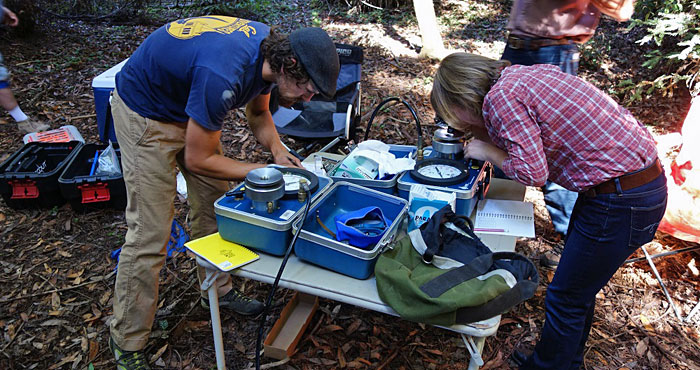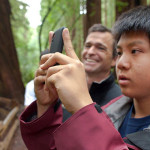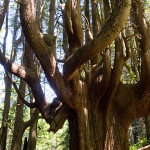
Is California’s severe drought affecting the redwood forest? If so, to what extent? To find the answers to these questions, the League’s Redwoods and Climate Change Initiative (RCCI) scientists climbed high into the canopy.
Led by Anthony Ambrose of the University of California, Berkeley, members of the RCCI team ascended young and old coast redwood, Douglas fir and bay laurel trees in Henry Cowell Redwoods State Park to collect samples and find out how the trees are faring under dry conditions. Redwoods, which can live to be 2,500 years old, are famously resilient — imagine what a tree must withstand to survive for millennia! However, coinciding with this historic drought are more pervasive climate changes, such as higher temperatures and less fog, that could exacerbate the drought conditions and threaten the iconic redwoods.
To determine whether the redwoods are under stress, the scientists took clippings from the tops of the trees and placed them in a pressure chamber to determine their moisture levels. The more pressure needed to draw water from the clipping, the thirstier the tree. In addition to the samples taken at Henry Cowell, the team gathered samples at a plot in Miller Park, a warmer, more inland forest.
The initial data gathered from the samples indicate that the trees are experiencing some stress. “There does appear to be a drought signal that we’re seeing,” said Ambrose.
These results are a clue as to what the trees are currently experiencing, but we don’t know yet what the drought will mean for the redwood forest, or if there will be long-term impacts on the hardy trees. The RCCI team has taken their clippings back to the lab for further analysis, and they’ll return to the plots next year for tree-ring samples that will reveal how the trees’ growth has been affected. Whether the drought continues in coming years will likely influence the future of the forest, as will other shifts in climate patterns.
The League will continue to monitor and assess the well-being of the redwoods to ensure that we can take the best possible care of these special places. Stay tuned for more research results and support our research programs today by joining the League or renewing your membership. With your help, we’ll continue to uncover important information about these unique and precious forests.

